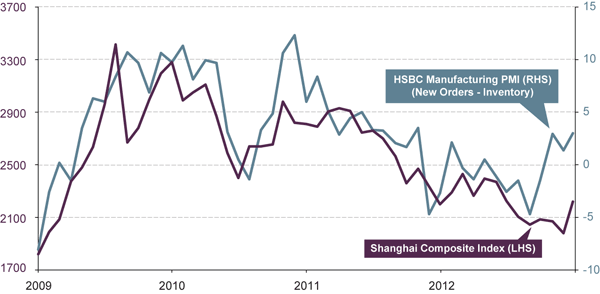by Scott Minerd, Chief Investment Officer, Guggenheim Partners LLC
"China has recently been showing signs of accelerating economic activity. The Shanghai Index is up 13% since the third of December. Xi Jinping, the new Chairman of the Communist Party, whose father was seen as one of Deng Xiaoping’s most reform-oriented lieutenants, appears to be dedicated to carrying out Deng’s vision and is likely to bring greater modernization and free-market capitalism to the Chinese economy. The much feared hard landing in China seems to now be a fading phantom, like the ghost of Christmas past.
Europe can be interpreted as the ghost of Christmas present this year. Although the economy there is not showing any significant improvements, the political process still seems to be moving forward. It appears there will be a new bank regulatory structure under the European Central Bank (ECB). With a centralized bank regulator in Europe it will be much easier for the ECB to manage the individual financial crises within each country.
In the U.S., we should not be fearful of the ghost of Christmas yet to come. Markets are discounting mechanisms, and the stall in fourth quarter equity performance reflects the fact that the uncertainty around the fiscal cliff has already been priced in. In spite of the worries around the cliff, the real world fundamentals continue to improve. Virtually every piece of data that has come out lately indicates improving economic activity."
Economic Data Releases
U.S. Housing Strong, 3Q GDP Revised Up
The housing market showed continued strength over the past week, with existing home sales rising to an annual rate of 5.04 million in November, the most in three years. Housing starts in November decreased 3% MoM, but building permits rose to the highest level since July 2008. Home prices continued to increase in October with the S&P/Case-Shiller Home Price Index rising 0.66% from September for a YoY gain of 4.31%. Real GDP growth was revised up to 3.1% in the third quarter, with personal consumption also showing an upward revision to 1.6%. GDP growth was also bolstered by foreign trade and state and local government spending. Personal income showed a strong increase of 0.6% in November, the fastest expansion in nine months. Durable goods orders rose for a third consecutive month in November and the Philadelphia manufacturing index rose to an eight-month high. Initial jobless claims increased 17,000 to 361,000 for the week of December 15th. The University of Michigan consumer confidence survey fell to a five-month low of 72.9 in December, and the leading indicators index fell 0.2% in November.
European Surveys Inch Up, Bank of Japan Easing Again
Consumer confidence in the eurozone increased slightly from a three and a half year low to -26.6 in the December flash estimate. Other surveys showed small or no gains, as the IFO Business Climate survey in Germany rose from 102.0 to 102.4 in December, French business confidence was unchanged at 89, and Italian consumer confidence increased 0.9 to 85.7 in December. In Italy, industrial orders were flat in October while retail sales fell for a fourth consecutive month. In the United Kingdom, real GDP growth was revised down to 0.9% in the third quarter, and retail sales (excluding auto fuel) also disappointed with no growth from October to November. In Japan, the Bank of Japan expanded its asset purchase program by ¥10 trillion and left the interest rate unchanged.
Chart of the Week
China’s Manufacturing Index and Equity Performance
Since the beginning of this month, China’s stock market index – the Shanghai Composite Index has climbed 13.2%. The robust equity performance has been associated with the recent positive economic data in China. Since bottoming in August, the HSBC Manufacturing PMI survey has rebounded strongly. During this time, many other economic indicators for China have also turned up, suggesting a broad-based acceleration in economic activities. Historically, the difference between manufacturing PMI sub-indices of ‘New Orders’ and ‘Inventory’, which can be interpreted as a measure of manufacturing momentum, has corresponded closely with Chinese equities performance. The sharp rise seen in this measure of manufacturing momentum over the past few months suggests that Chinese equity prices may follow suit in the near-term.

Source: Bloomberg, Haver, Guggenheim Investments. Data as of 12/17/2012.
This article is distributed for informational purposes only and should not be considered as investing advice or a recommendation of any particular security, strategy or investment product. This article contains opinions of the author but not necessarily those of Guggenheim Partners or its subsidiaries. The author’s opinions are subject to change without notice. Forward looking statements, estimates, and certain information contained herein are based upon proprietary and non-proprietary research and other sources. Information contained herein has been obtained from sources believed to be reliable, but are not assured as to accuracy. No part of this article may be reproduced in any form, or referred to in any other publication, without express written permission of Guggenheim Partners, LLC. ©2012, Guggenheim Partners. Past performance is not indicative of future results. There is neither representation nor warranty as to the current accuracy of, nor liability for, decisions based on such information.
Copyright © Guggenheim Partners LLC













